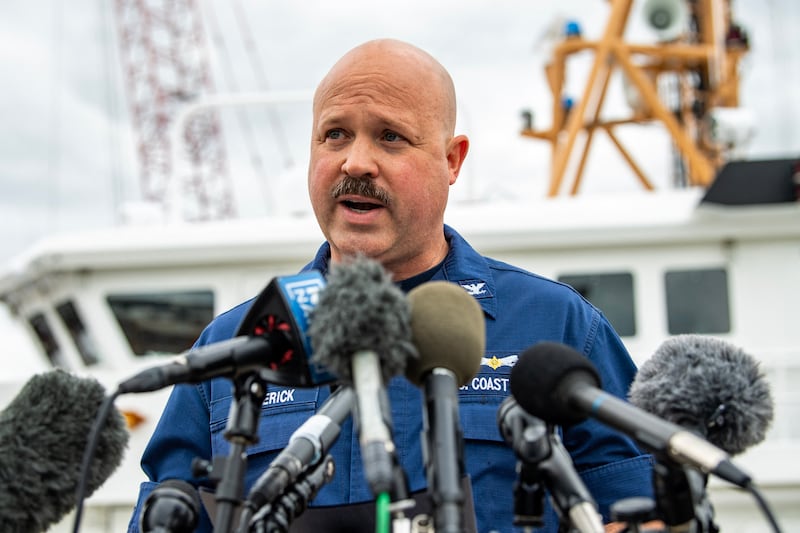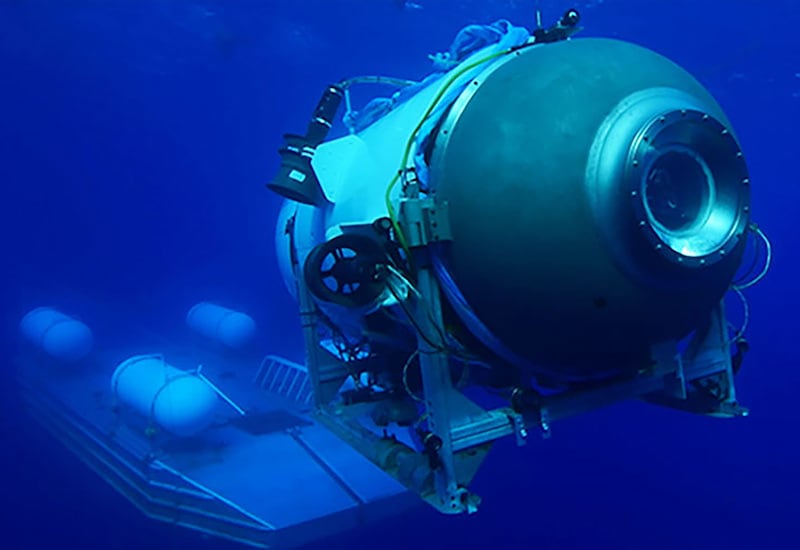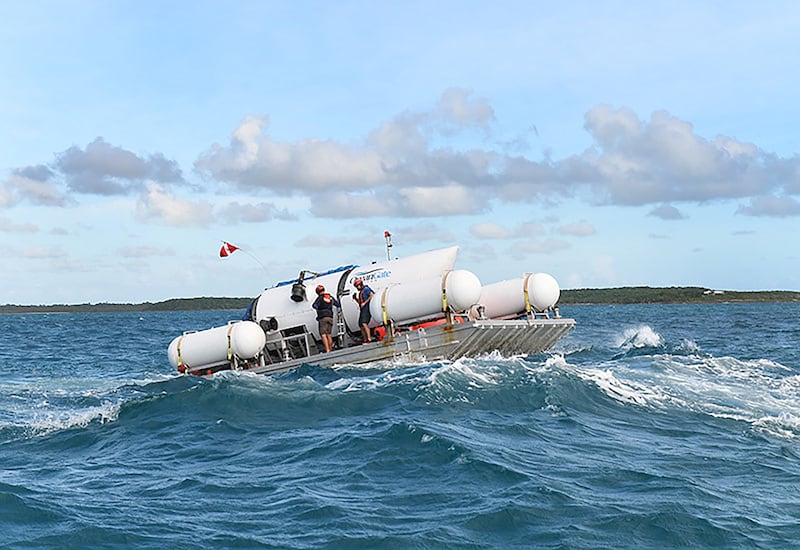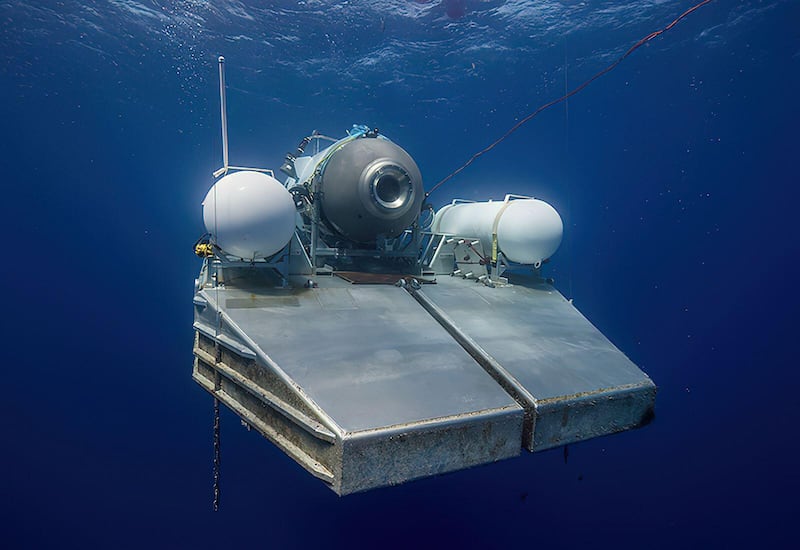“Underwater noises” have been detected in search for the missing Titan submersible vessel that disappeared in the North Atlantic on Sunday while on a dive to the site of the Titanic shipwreck. The search is continuing on Wednesday.
Here’s what we know so far:
- Less than 24 hours of oxygen left on OceanGate Expeditions vessel
- Underwater noises detected in the search area of a missing deep-sea vessel is a “target” and a “focus” for the rescue operation, the US Coast Guard has said.
- Remote-operated vehicles being used in the search have been relocated in an attempt to find the source of the underwater noises
- The vessel went missing on Sunday morning, beginning an international search operation covering some 25,9000 sq km of ocean
- Contact with the vessel was lost about an hour and 45 minutes into its dive, some 640km off the coast of Newfoundland, Canada
- There are reportedly five passengers onboard: British billionaire and adventurer Hamish Harding, Shahzada Dawood, his son Suleman, OceanGate’s chief executive and founder Stockton Rush and French submersible pilot Paul-Henry Nargeolet
- Catch up on Tuesday’s developments in the search here
Despite the lack of any real progress today, Fanning said he remains hopeful of a good outcome.
“I’m hopeful because of their professionalism, and I’m also hopeful because of the professionalism of the two people that are with them,” he said.
“Two very serious businessmen, from what I can gather. I don’t know either of them. I would think they would follow commands very, very judiciously.
“They’ll be keeping their breathing calm, doing exactly what they’re supposed to. I’ve no knowledge of it, but the reports are they’re hearing an odd bang every 30 minutes.
“You know, that would be exactly what they do. They conserve their energy because they would have known how long it would take for some ROV or anything to get down to that depth. They would have known that would take days.”
Fanning said the vessel will have to surface on its “own steam” if it can be pulled free from whatever it is may be trapping it.
“They have to be pulled free so that they can go up under their own steam. It is designed to do that and the only reason it clearly hasn’t done up is something’s holding it back. So you know if you can’t pull it out, it’s catastrophic.”
Fanning has just been speaking to Channel Four News as well.
He said the search should be focused on the site of Titanic wreck.
“It should be on the wreck in my opinion, There’s nothing else that could trap it that I can see. So if it’s not something catastrophic it has to be trapped somewhere on the wreck and if someone gets down there it would be very easy to find.”
Asked what may have happened to the Titan, Fanning said something may have “broken off” the submersible.
“I would have to presume that something’s broken off or that something hit one of the areas – anything could have happened to break it off – once that’s broken, your contact is gone,” he said.
He added that there are currents in the depths of the ocean of about several knots that could drag the Titan away from the Titanic.
Fanning said the passengers would have been advised “not to panic”, and that this will be key to their chances of survival.
“They will be used to not panicking as well so I think they will follow directions perfectly and they will conserve as much energy as possible. That is, if they are trapped, in the hope that somebody would come down and release them,” he said.
Speaking earlier, Irishman Oisin Fanning, who is executive chairman of oil and gas exploration firm San Leon, spoke to the BBC about visiting the Titanic wreck twice with OceanGate Expeditions.
He described two of the passengers – French explorer Paul-Henri Nargeolet and Stockton Rush, the chief executive of OceanGate – as “consummate professionals”.
“If I was in trouble I would want to be on a sub with them,” he said.
Fanning added: “They would be conserving energy from day one so I wouldn’t be surprised if the oxygen lasts a lot longer because they’ll know exactly what to do.
“You’re talking about people who have dived to the Titanic alone 38, 40 times.”
‘Wild goose chase’
Chis Parry, a former rear admiral with the Royal Navy, has told Sky News he is concerned about the focus of the operation on the banging noises, suggesting it could be a “wild goose chase”.
“I have to say, this ‘banging sounds’ story is pretty spurious,” he said. “There is a lot going on in the ocean. You’ve got Titanic banging away with all its deteriorating structures next door.
“I wonder if they are actually slightly embarrassed by making such a story of this. They say they are actually focusing their search on it.
“To my mind, the Titan was going down to Titanic. If that’s where she was going, that’s where you start your search and you expand it out in circles.
“I’m really worried in case these spurious sounds are taking people away from where the Titan might be.”
Another reporter asked if the “banging” noises that were heard could have been caused by mammals in the ocean, or if some animals could mimic human sounds.
Carl Hartsfield said: “From my experience with acoustics, there are sounds by biologics that sound man-made to the untrained ear, but I can assure you the people listening to these tapes are trained.
“There are a lot of vessels in the area, and they each make noise. All of that has to be eliminated.”
Carl Hartsfield of the Woods Hole Oceanographic Institution said it is very difficult to discern what the noises are in the ocean.
He said the team has multiple sensors. They are in the area and sending data back expeditiously to the best people in the world to analyse.
They then in turn are feeding the results of that analysis back to the team, and they are making decisions on that basis.
His group is there is an advisory roles, but added: “By our expertise, what I see is a very tight operational loop that is making decisions based on data and nothing is ruled out.”
Captain Frederick said one of the aircraft did see an object in the water yesterday.
“In seach and rescue missions, when aircraft are flying continuously, there is stuff out in the ocean that is floating. We went back and looked at it. We didn’t determine it to be debris. We don’t think it correlates with the case.”
The ROVs are currently searching can travel to depths of 4,000 metres. The wreck of the Titanic, for context is at a depth of 3,800 metres.
The additional ROVs arriving tomorrow will have additional depth capability.
One of the reporters at the press conference asked about talk of the noises being heard at 30 minute intervals, which I presume would be significant as a regular pattern would indicate intelligent action.
However, Captain Frederick said he hadn’t heard about 30 minute intervals.
He said he is not a trained ear for underwater aquatics.
The data was sent to the navy last night and analysed. “They are still looking at it, but I can tell you it is inconclusive,” he said.
He said search teams have to factor in the “ever changing weather conditions, currents, and sea states that expand the search area every hour”.
He added: “There is an enormous complexity associated with this case due to the location being so far offshore and the coordination between multiple agencies and nations.”
Captain Frederick said the ROV searches of the areas where the noises were detected have yielded negative results, but that they continue.
Additionally, the data from the P-3 aircraft has been shred with US Navy experts for further analysis, which will be considered in future search plans.
The search area has been exponentially expanded, he added.

Captain Frederick said they have received “incredible support” with aviation assets from a number of agencies.
Today there are two back-to-back P-3 flights, one of which is ongoing now, totalling 14 hours of continuous coverage.
There are also two C-130 flights, one of which is also ongoing now, throughout the day and into the evening.
The P-3 is a four-engine, turboprop anti-submarine and maritime surveillance aircraft developed for the United States Navy and introduced in the 1960s. One of these aircraft, albeit belonging to the German Navy, is pictured above.
The C-130 is a four-engine turboprop military transport aircraft. It is capable of using unprepared runways for take-offs and landings, and was originally designed as a troop, medevac, and cargo transport aircraft.

To recap, Captain Frederick said the location of the search makes it “exceptionally difficult” to mobilise large amounts of equipment quickly.
Despite this, they have been able to provide continuous air and surface search assets, as well as additional capability below the surface.
They currently have five surface assets searching, and they expect this to double in the next 24-48 hours.
There are two “ROVs” actively searching and several more are en route and will arrive by tomorrow morning.
ROV stands for remotely operated vehicle. They are unoccupied, highly manoeuvrable underwater machines that can be used to explore ocean depths while being operated by someone at the water surface.
The press conference has concluded. He has loosely committed to holding a daily press conference from this point on.
We will bring you a few more bits from it now as well.
He won’t put a percentage on the likelihood of survival beyond tomorrow morning when the oxygen supply is scheduled to run out.
He is saying little about the noises they heard beyond that they are continuing to search that area.
“It’s all speculation and we are not in the business of speculation,” he adds.
Captain Frederick says more assets are on the way and they will continue to deploy them in the best places they can.
He is asked how long they will continue to search. He says: “We have to remain optimistic and hopeful.”
He adds: “You have to consider all the factors, and there are lots of factors. Sometimes you are in a position where you have to make tough decisions. But we are not at that point yet.”
Carl Hartsfield of the Woods Hole Oceanographic Institution says the noises in the ocean are complicated.
“They have to put the whole picture together in context and eliminate potential manmade sources other than the Titan,” he says.
He says the people listening to the noises are trained and know what they are doing.
With respect to food and water, he says there are limited rations aboard. They don’t know exactly how much.
He is asked about how much hope they can give to the families, but he swerves the question.
On the oxygen time, he says this is not the only thing that is important.
“We’re focused on search and rescue at the moment.”
Captain Frederick says it is imperative that everyone continues to work together.
He is taking questions now.
On the noises that were heard, Captain Frederick says they “always have hope”, but adds: “We don’t know what they are, frankly.”
He adds: “We are continuing to search in those areas where the noise was detected.”
Search results following the underwater noises detected have yielded negative results so far.
The sub-surface search is now in an area that is 2.5 miles deep. The search operation on the surface now covers an area twice the size of Connecticut.
Captain Frederick says they are keeping the families of those on board the Titan in the loop on the rescue efforts.
A team of highly trained French operatives are en route to the scene.
He reiterates that this is an “extremely complex” operation. The underwater conditions are making it very difficult to manoeuvre underwater equipment.
The press conference has just got underway and is being led by US Coastguard captain Jamie Frederick.
Of course, locating the missing vessel would be just the first problem solved.
Mounting a sub-to-sub rescue on the ocean floor has been said to be virtually impossible, so it would be up to rescue teams to devise a way to solve whatever problem it is that has trapped the Titan or prevented it from surfacing.
Speaking to PA news agency, former Royal Navy submarine captain Ryan Ramsey has said the rescue operation is made harder due to there being no replica of the Titan to model a rescue attempt off should they find it.
He said: “It would have to be bespoke equipment. I don’t think anyone has planned for this kind of operation so they would have to create some kind of bespoke process to get a cable round or a fixing point on that particular submersible.
“The problem with that is, with most submersibles, they make two of them. They make two of them for reasons – for example, something does happen to one of them the rescuing porters can go see the other one and figure how they’re going to exercise the rescue.
“In this particular case, they only made one and so there’s no opportunity for people to work out what that solution is and to work that problem through and achieve a successful outcome.”

The United States Coast Guard is due to hold a press conference on the ongoing efforts to retrieve the Titan submersible in just under half an hour (6pm).
We will bring you all the updates from that here as they happen.
It is worth remembering at this stage who is on board the Titan.
HAMISH HARDING. The British billionaire and chairman of aviation company Action Aviation is among those missing. Dubai-based Harding had posted on social media that he was proud to be heading to the Titanic as a “mission specialist”. Harding was also on board the 2019 “One More Orbit” flight mission that set a record for the fastest circumnavigation of earth by aircraft over both geographic poles. “He doesn’t stand still. If he’s not working hard, he’s exploring hard,” said Jannicke Mikkelsen, an explorer and friend of Hamish.
SHAHZADA DAWOOD and his son SULEMAN. Their family have confirmed they are on board. Shahzada is vice chairman of one of Pakistan’s largest conglomerates, Engro Corporation, with investments in fertilisers, vehicle manufacturing, energy and digital technologies. According to the website of SETI, a California-based research institute of which he is a trustee, he lives in Britain with his wife and two children. Shahzada’s interests include wildlife photography, gardening and exploring natural habitats, while Suleman is a fan of science fiction literature, according to a statement from the Dawood Group.
PAUL-HENRI NARGEOLET. The 77-year-old French explorer, whom media say is one of the five on board, is director of underwater research at a company that owns the rights to the Titanic wreck. A former commander in the French Navy, he was both a deep diver and a mine sweeper. After retiring from the navy, he led the first recovery expedition to the Titanic in 1987 and is a leading authority on the wreck site. In a 2020 interview with France Bleu radio, he spoke of the dangers of deep diving, saying: “I am not afraid to die, I think it will happen one day.”
STOCKTON RUSH. The founder and CEO of the vessel’s U.S.-based operating company OceanGate is also on the submersible, according to media reports. “It is an amazingly beautiful wreck,” Rush told Britain’s Sky News of the Titanic earlier this year. “Rush became the youngest jet transport rated pilot in the world when he obtained his DC-8 Type/Captain’s rating at the United Airlines Jet Training Institute in 1981 at the age of 19,” according to his biography on OceanGate’s website.
Some more info from Rear Admiral John Mauger, of the US Coast Guard.
Speaking on the BBC this afternoon he said there were a number of different vessels undergoing both surface and sub-surface searches for Titan.
“This has been a very complex and difficult case for all of us but as we continue to actively search for the submersible and the people onboard our thoughts are with the crew members and their families who, I can imagine, are having a very difficult time at this point.
“We’re working very hard in a unified command structure with US government agencies, including the US Navy, with Canadian agencies, including the Canadian Coast Guard and Canadian armed forces, and then also with private sector entities including the OceanGate expedition.
“We’re focused on bringing all assets available to bear on the search for the submersible. This has happened in a remote location 900 miles off our coastline here in Cape Cod within the Coast Guard’s first district search zone.
“We have prioritised effort on both a surface search and then a sub-surface search so we have two vessels, two remote-operated vessels a remote-operated vehicle conducting a sub-surface search and we have an aircraft and surface vessels which are conducting the surface search at this moment.”
There were glimmers of hope this morning after noises were picked up from around where the five people went missing. However expectations that it might lead to a successful search and rescue operation were downplayed this afternoon with the source of underwater noises still unknown.
R Adm John Mauger, who is heading the search for the Titan, confirmed an aircraft had detected noise in the water picked up by sonar buoys on Tuesday, but said: “We don’t know the source of that noise.”
He said there were a lot of metal objects at the site of the Titanic wreck, which could be where the noise was coming from.
Mauger also told CBS News that the search operation would continue “as long as there’s an opportunity for survival”.
Reuters has published an useful timeline of what has happened so far and what might happen next.
SATURDAY Saturday evening British billionaire and adventurer Hamish Harding, one of those aboard the submersible, posts on Facebook: “Due to the worst winter in Newfoundland in 40 years, this mission is likely to be the first and only manned mission to the Titanic in 2023. A weather window has just opened up and we are going to attempt a dive tomorrow.”
“More expedition updates to follow IF the weather holds!”
He does not post again on Facebook.
SUNDAY 0800 GMT - Time the submersible originally aimed to start its descent, according to a post by Harding on Instagram. But it starts its descent later, according to the U.S. Coast Guard.
1200 GMT Titan submersible starts what should be a two-hour descent to the Titanic wreck, which lies at a depth of 12,500 feet (3,810 meters) in the North Atlantic, U.S. Coast Guard says.
1345 GMT Communications between the submersible and the surface vessel are lost 1 hour and 45 minutes after starting its descent, the U.S. Coast Guard says.
1900 GMT The submersible is scheduled to return to the surface, the U.S. Coast Guard says. It fails to appear.
2140 GMT Coast Guard receives report about an overdue submersible from the Canadian Research Vessel Polar Prince with five people aboard diving to view the Titanic wreck about 900 nautical miles east of Cape Cod on the U.S. coast.
MONDAY
U.S. and Canadian ships and planes are swarming the area, some dropping sonar buoys that can monitor to a depth of 13,000 feet (3,962 meters), U.S. Coast Guard Rear Admiral John Mauger says. He adds it is a remote area and a challenge to conduct a search. Officials have also asked commercial vessels for help.
TUESDAY
MORNING - The family of Pakistani-born businessman Shahzada Dawood confirm he is aboard with his 19-year-old son Suleman. They ask for prayers for their safety.
1450 GMT France says it will help with search by deploying Atalante, a ship equipped with a deep-sea diving vessel and managed by the Ifremer ocean research institute.
DURING THE DAY Sounds detected over several hours by Canadian Lockheed P-3 Orion aircraft, equipped with gear to trace submarines. The U.S. Coast Guard - which announces this on Wednesday - does not give a precise timing.
CNN and Rolling Stone magazine reports Canadian aircraft detected banging sounds at 30-minute intervals. Rolling Stone says sonar picks up more banging four hours later. CNN also reports later sounds but does not describe them as banging. Harding’s friend, Jannicke Mikkelsen, says: “And as it stands right now, it would be a miracle if they are recovered alive.”
WEDNESDAY
DURING THE DAY - U.S. Coast Guard, U.S. Navy, Canadian Coast Guard and OceanGate Expeditions establish a unified command to handle the search.
0600 GMT - U.S. Coast Guard announces Canadian P-3 aircraft detected underwater noises. It says remotely operated vehicle (ROV) searches are directed to the area of the sounds and the data are also sent to U.S. Navy experts for analysis.
LATE ON WEDNESDAY French research ship, equipped with a deep-sea diving vessel, expected to arrive at search area.
THURSDAY
1000 GMT Rough deadline for when the air in the submersible will run out, based on the U.S. Coast Guard’s estimate. The vessel has 96 hours of air supply from the time it is sealed, according to its specifications. This depends on the vessel being intact and other factors, such as whether the sub still has power in the icy depths.
Here is the latest report from the news wires.
Underwater noises detected in the search area of a missing deep-sea vessel is a “target” and a “focus” for the rescue operation, the US Coast Guard has said.
The US Coast Guard announced earlier on Wednesday that the Canadian P-3 aircraft detected underwater noises.
Rear Admiral John Mauger told CBS News: “This is an incredibly complex site there, you have to remember that it’s the wreck site of the Titanic, so there is a lot of metal and different objects in the water around the site.
“That’s why it’s so important that we’ve engaged experts from the navy that understand the science behind noise and can classify or give us better information about what the source of that noise may be.
“In the meantime, it’s something, it’s a target, it’s a focus for us to look at.
“We’ve deployed the remote-operated vehicles and the surface vessel, the Canadian Coast Guard surface vessel, that has sonar capability in the vicinity of that to see if we can detect anything in the water in that area.”
“An exceptionally hostile environment... We are in a collapsing time frame at the moment.” Pretty bleak assessment of what the challenges facing recusers are.
“He’s been in all kinds of problematic situations and he’s resolved them … He’s the guy you want next to your side in this kind of situation,” Joe MacInnis - who has made two trips to the Titanic speaking on CNN about Paul-Henri Nargeolet, one of the five people onboard the submersible He added that the five’s main focus would be “conserving energy. Resting, breathing as little as possible, and trying to keep calm. That is the most important thing.”
There are now at least five vessels at the Titanic wreck site with more on the way according to a report on Sky News. The research vessel Polar Prince, the Titan submersible’s “mother ship”, was at the site, as was a Bahamian pipe-laying vessel, Deep Energy, and a commercial Vessel, Skandi Vinland. The Canadian coastguard vessels John Cabot and Atlantic Merlin arrived overnight with others on the way.

A businessman who has made the deep-sea voyage to the wreck of the Titanic has expressed confidence in the Titan crew and said “there’s a very good chance they will be found”.
Oisin Fanning told BBC Radio 4′s Today programme he had been on the submersible with pilot Paul-Henri Nargeolet and OceanGate chief executive and founder Stockton Rush, who are both reportedly on board the missing vessel.
“The two guys on the sub currently, so Paul and Stockton, are both consummate professionals,” he said.
“I mean, to be honest, if I was in trouble, I’d want to be on a sub with them.”
Mr Fanning continued: “They will be conserving energy from day one. So I wouldn’t be surprised if the action lasts a lot longer because they’ll know exactly what to do.
“I mean, you’re talking about people who have dived to the Titanic alone 38, 40 times – you know, their career’s about diving.”
They will be advising the people on board with them “not to panic”, he added.
“I think there’s a very good chance they will be found. These are not fly-by-nighters, these are very highly professional people.” – PA

For more detail on the conditions inside the submersible during a dive, read this piece here:
Inside the Titan: A tight fit and a view from a single porthole
Dik Barton, the first British diver to see the Titanic wreck, said it is a “dangerous” and “hostile” place to be.
He told ITV’s Good Morning Britain he has “100 per cent” felt in danger during previous expeditions to the wreck site.
“It’s a very, very dangerous, hostile place to be,” he said. “There’s a local ebb and current of water which moves around, it’s not consistent. The strength of the submersible is relatively limited.”
He added: “The thrusters are quite strong but, at the end of the day, you have to conserve your power because it’s your life support system and navigation system.”
Mr Barton told the programme he is friends with Paul-Henry Nargeolet, reported to be on board the missing vessel, and referred to him as “PH”.
“PH is an extremely capable submersible operator pilot,” he said. “He is a deep water explorationist, he’s been down [to] the Titanic 37 times.
“I’ve worked with him extensively, I have enormous respect for him and his ability, and, quite frankly, if there’s anybody I’d ever want to be in a position, God forbid, in this circumstance then it would be PH.
“He will be certainly doing all he possibly can to make sure everyone is calm and collected and waiting for recovery.”
Mr Barton said there is no way of accessing the submersible on the sea bed and that for passengers and crew to be rescued the vessel has to be recovered back to the surface. – PA

The interior of the submersible is a cramped space. It can take up to 10 hours to descend from the ocean’s surface to the wreck of the Titanic, almost 4km down on the seafloor.
David Pogue, a CBS reporter and former New York Times tech columnist who has been on board, described the cylinder as “about the size of a minivan”.
Images from OceanGate show a vessel with an interior like a metal tube, where passengers can sit on the flat floor with their backs to the curved walls. There is some overhead lighting but no chairs, and little room to move or stand upright.
Mike Reiss, a producer and writer for The Simpsons who went down on a previous expedition, said passengers were required to sign a waiver that mentioned death three times on the first page.
Mr Reiss described the journey to the Titanic as “very comfortable” and said he fell asleep during the quiet, dimly lit descent. “You just drop like a stone for two and a half hours,” he said.
Sandwiches and water were available on the vessel, but he recalled being told that many passengers did not eat during the journey because of excitement, and that the rudimentary toilet on board had never been used.
As the submersible made its way to the Titanic, Mr Reiss said, it was carried off course by underwater currents. The compass was “acting very weird”, he recalled, and the team knew only that they were about 500 yards from where they should have been.
Still, the Titan, which could spend only three hours on the ocean floor, managed to arrive at the wreck with roughly 20 minutes to spare for what Reiss called a quick “photo op”. He was able to see the sunken ship through the porthole, which he described as the size of a washing machine window.
The wreck was “the biggest thing in the world,” he said, “but you’re in such darkness, you just don’t know where it is going to be.” – New York Times
Chris Parry, a retired navy rear admiral from the UK, said without an “emitting signal” from the missing deep-sea vessel near the wreck site of the Titanic it will be “impossible” to find in the time scale.
He told LBC Radio: “I’m afraid the odds are vanishingly small.”
“Obviously, we want to remain hopeful and optimistic but there are two problems here – one is actually finding the thing and secondly is how on earth are you going to get it off the seabed. It’s never been done before and I don’t think anybody’s got any ideas about how to do it at the moment.”
He added: “You’ve got this vastly complex seabed with all the debris of the Titanic, you’ve got hills and canyons and everything, and I’m afraid to say without an emitting signal from the vehicle itself it’s almost, well, I’d say it’s impossible to find in the timescale.”
He went on: “Why on earth you would go in a dodgy piece of technology where you actually have to sign away any right to sue the company for emotional damage, injury or death is beyond me.
“It is fundamentally dangerous, there was no back-up plan, it’s experimental and I’m afraid to say there’s an element of hubris if you want to go down and do that.” – PA

A friend of Hamish Harding has described him as “the quintessential British explorer” as the search-and-rescue mission for the Titan continues.
Col Terry Virts, a former commander of the International Space Station, spoke to Nick Robinson on BBC Radio’s Today programme about Mr Harding’s love of adventure.
He said: “Some people watch Netflix and some people play golf, and Hamish goes to the bottom of the ocean or into space or, you know, he sets world records flying around the planet.
“As I’ve said several times now, Hamish is the quintessential British explorer. He loves adventure. He loves exploring and that’s just the kind of person he is.”
Asked whether Mr Harding was “addicted to risk”, Colonel Virts replied: “No, not all.
“I don’t think Hamish is an adrenaline junkie at all. That’s not Hamish. He likes exploration. And, you know, exploration involves risk, but he’s also very methodical about it.” – PA
Chris Brown, an explorer and friend of British billionaire Hamish Harding, said making “banging sounds” is the kind of thing his missing friend would do.
He told BBC Breakfast: “That is just the sort of thing I would have expected Hamish to come up with.”
He added: “There’s always hope. As an explorer, you never give up anyway.” – PA

Rescuers face major obstacles both in finding the Titan and in saving the people aboard, according to experts.
In the event of a mid-dive emergency, the Titan’s pilot would likely have released weights to float back to the surface, according to Alistair Greig, a marine engineering professor at University College London. But absent communication, locating a van-sized submersible in the vast Atlantic would prove challenging, he said.
The submersible is sealed with bolts from the outside, preventing occupants from escaping without assistance even if it surfaces.
If the Titan were stuck on the ocean floor, a rescue effort would face even greater challenges due to extreme hydrostatic pressure and total darkness on the sea floor more than 3km deep. Titanic expert Tim Matlin said it would be “almost impossible to effect a sub-to-sub rescue” on the seabed. – Reuters
The clock is ticking down to the last 24 hours of the craft’s presumed oxygen supply.
The mini-sub was designed to remain underwater for 96 hours, according to its specifications, giving its occupants until Thursday morning before their air tanks would run out, assuming that the Titan was still intact.
Those aboard Titan for a tourist expedition that costs $250,000 per person but authorities have not confirmed the identities of any of the passengers.
As well as US and Canadian efforts, a French research ship carrying its own deep-sea diving robot submersible was dispatched to the search area at the request of the US navy and was expected to arrive Wednesday night local time, the Ifremer research institute said.
CNN and Rolling Stone magazine, citing internal US government communications, independently reported late on Tuesday that banging sounds were detected by Canadian aircraft at 30-minute intervals in the search area.
Rolling Stone, the first to report the news, said the sounds were picked up by sonar buoys and that additional sonar picked up more banging four hours later.
CNN cited a US government memo as saying that additional sounds were heard about four hours after initial banging was detected, although the news channel said the second occurrence was not described as banging. – Reuters
US coast guard captain Jamie Frederick has told reporters that US and Canadian aircraft have searched more than 25,900 sq km of sea.
The Titanic shipwreck lies 1,450km east of Cape Cod, Massachusetts, and 644km south of St John’s, Newfoundland. Canada’s Polar Prince ship has been conducting surface searches alongside a Canadian Boeing P-8 Poseidon reconnaissance aircraft, Associated Press reports.
The Canadian military has dropped sonar buoys to listen for any possible sounds from the Titan. An underwater robot is also searching in the vicinity of the Titanic. Two US Lockheed C-130 Hercules aircraft have been conducting overflights.
To aid the search, three C-17s from US air mobility command have moved another commercial company’s submersible and support equipment from Buffalo to St John’s. A Canadian navy ship carrying a medical team specialising in dive medicine and a six-person mobile hyperbaric recompression chamber was also en route on Wednesday. – Guardian
A former employee of OceanGate had raised concerns over “safety and quality control issues regarding the Titan to OceanGate executive management”, according to court filings.
David Lochridge, OceanGate’s former director of marine operations, claimed in the August 2018 court document he was wrongfully fired after flagging worries about the company’s alleged “refusal to conduct critical, non-destructive testing of the experimental design”.
After “issues of quality control” with Titan were raised, the filings say OceanGate chief executive and founder Stockton Rush asked Mr Lochridge was asked to conduct a “quality inspection” report on the vessel.
During this process, Mr Lochridge “identified numerous issues that posed serious safety concerns” but he was allegedly “met with hostility and denial of access” to necessary documents before later being fired.
The document claims he became concerned about a “lack of non-destructive testing performed on the hull of the Titan”, and that he “stressed the potential danger to passengers of the Titan as the submersible reached extreme depths”.
In a November 2022 episode of his Unsung Science podcast, CBS journalist David Pogue interviewed Mr Rush ahead of going on a Titan expedition to the wreckage.
In the podcast, Mr Rush told him: “You know, at some point, safety is just pure waste.
“I mean, if you just want to be safe, don’t get out of bed, don’t get in your car, don’t do anything.
“At some point, you’re going to take some risk, and it really is a risk-reward question.
“I think I can do this just as safely by breaking the rules.”
Mr Pogue also said he had signed a waiver before going on the dive which allegedly said: “The experimental submersible vessel has not been approved or certified by any regulatory body” and that the trip could result in death.
OceanGate has been approached for comment. – PA
The Explorers’ Club, of which the British billionaire Hamish Harding is a founding member, shared an upbeat message on Wednesday morning.
President Richard Garriot de Cayeux said in a statement: “There is cause for hope, that based on data from the field, we understand that likely signs of life have been detected at the site.
“They precisely understand the experienced personnel and tech we can help deploy ... We believe they are doing everything possible with all the resources they have.”
Mr Garriot de Cayeux said they are ready to provide the UK-based Magellan’s remotely operated craft that is certified to travel as deep as 6,000m. – PA
A Canadian surveillance aircraft looking for the missing Titan submersible in the North Atlantic “detected underwater noises in the search area,” the US coast guard (USCG) said late Tuesday.
The USCG said in a brief statement on Twitter that some of the remote-operated vehicles involved in the search had been relocated in an attempt to determine the origin of the sounds. Those searches had so far “yielded negative results” but were continuing, the statement said.
The USCG, the US department of homeland security and the Canadian military did not immediately respond to requests for comment Tuesday night. – The New York Times
















